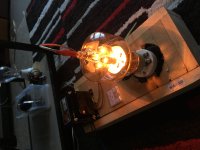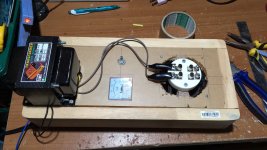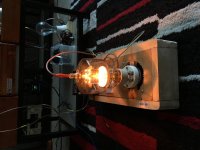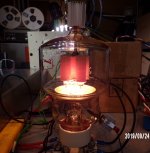Attachments
Last edited:
I think should have a heat sink on the Anode
hello yes i go to built 304TL amp ,
i use SV-LED-325E from mouser for plate
grid also need heat sink, SV-LED-314E can do it
Attachments
Jeffrey Jackson has some published curves that will make your mouth water.
Type 304TL is gettered by coatings on the anode, so the beginnings of a 304TL project need to include a procedure to exercise the getters at red-plate while observing grid current. (I hope that's good enough.) My build partner Iain and I are currently making a dedicated chassis with a coupla meters (for smash) to refresh-getter and test these great valves.
Type 304TL operate amazing linearly into a 5000 reflected Ohm load with the same drive voltage as a type 211 (same mu = 12, but 3 times bigger, and made to win the War).
Dude, you're crushin' it. (Bill Burr)
All good fortune,
Chris
Type 304TL is gettered by coatings on the anode, so the beginnings of a 304TL project need to include a procedure to exercise the getters at red-plate while observing grid current. (I hope that's good enough.) My build partner Iain and I are currently making a dedicated chassis with a coupla meters (for smash) to refresh-getter and test these great valves.
Type 304TL operate amazing linearly into a 5000 reflected Ohm load with the same drive voltage as a type 211 (same mu = 12, but 3 times bigger, and made to win the War).
Dude, you're crushin' it. (Bill Burr)
All good fortune,
Chris
saw these on EPay
304TH / VT254 / VT-254
ube type : 304TH / VT254 / VT-254
Manufacturer (1) : Various brands
Manufacturer (2) : N/A
Country : Various
Function : Triode
Base : 4-pin
crazy price
US $495.00
Approximately AU $721.62
1 X 304TH TUBE EITEL McCULLOUGH INC. 1945 S . NOS/NIB. | eBay
304TH / VT254 / VT-254
ube type : 304TH / VT254 / VT-254
Manufacturer (1) : Various brands
Manufacturer (2) : N/A
Country : Various
Function : Triode
Base : 4-pin
crazy price
US $495.00
Approximately AU $721.62
1 X 304TH TUBE EITEL McCULLOUGH INC. 1945 S . NOS/NIB. | eBay
Note that type 304TH is a high-mu version not really suitable for an audio output stage.
All good fortune,
Chris
Both 304tl and 304th have low mu, low enough for a SE amplifier. I have tried both and work excellent. The 304th is a higher mu version of 304tl gut not so high to be prohibited for SE CLASS A service. Also, their RP is between 600 and 1000 ohm according to my tests making them particularly suited for SEclassA.
Maybe we should just say that this is a judgment call. Transformers for these big guys are difficult enough to make with sufficiently low parasitic impedances that the lower the source resistance (dynamic anode resistance) the better the performance. Of course.
My argument might be that a larger class-A1 current swing and a lower dynamic anode resistance are more important than a smaller driving voltage, especially for such an extreme build. If we're not aiming for the very best possible, why go to all the extra bother of big Eimacs?
All good fortune,
Chris
My argument might be that a larger class-A1 current swing and a lower dynamic anode resistance are more important than a smaller driving voltage, especially for such an extreme build. If we're not aiming for the very best possible, why go to all the extra bother of big Eimacs?
All good fortune,
Chris
- Home
- Amplifiers
- Tubes / Valves
- 304TL under test



